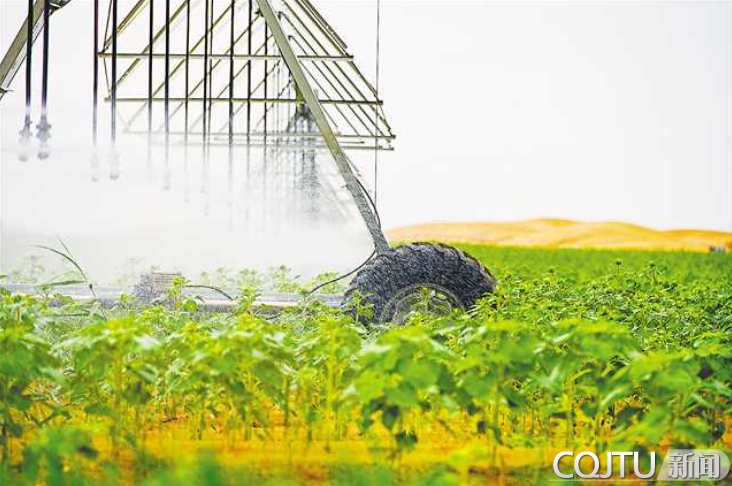Updated: June 12, 2023
Deep within the Kubuqi Desert, in Jirigalangtu Town, Hangjin Banner, Ordos City, Inner Mongoliat, a 25,000-acre green farmland now stabilizes the shifting sands. Tractors, seeders, and rotary plows rumble across the fields as workers plow, conduct soil tests, and install irrigation systems. This thriving oasis is part of the “desert soilization” project at a local ecological restoration site, showcasing how technology is turning barren desert into productive and arable land.
“Desert soilization doesn’t literally turn sand into soil, and it gives sand the properties of soil,” explains Zhao Chaohua, a member of the desert soilization team at CQJTU and the site’s technical lead. Standing in the fields, he enthusiastically demonstrates the process to reporters. “By combining sand with a constraining material and allowing it to absorb water, we enable it to transition between solid and rheological states, giving it both the mechanical properties of soil and the ability to retain water and nutrients.”
The experimental site is located in Hangjin Banner, which sits on the Ordos Plateau and the Hetao Plain, along the southern bank of the middle course of the Yellow River. Here, desert areas make up 52.2% of the total land, with severe desertification and soil erosion posing significant challenges to local economic development and livelihoods. To address this, Hangjin Banner adopted a “Project & Talent” approach, inviting Professor Yi Zhijian and his team from CQJTU to implement desert soilization technology. This innovative method is expected not only to restore and green barren desert land but also to establish a sustainable green supply chain, integrating environmental restoration with economic development.
As the project unfolded, apart from patented technology, all agricultural supplies—from fertilizers and plastic mulches to farming equipment—were sourced locally or from nearby areas, injecting over 20 million yuan into the town’s economy. Qi Rimai, Party Secretary of Jirigalangtu Town, highlighted the project’s success: “What was once barren desert has now become thriving farmland, ready for sustainable cultivation. This transformation has not only diversified local crops but also opened up vast new areas for farming.” Looking ahead, the town plans to collaborate with attractions like Qixing Lake to develop premium cultural and tourism experiences, seamlessly integrating economic growth, ecological restoration, and social progress into a unified vision.

The first phase of the project, spanning 2,500 mu (approximately 412 acres), has already proven to be a resounding success. A diverse range of over 20 crops—including sorghum, soybeans, corn, and potatoes—have thrived, culminating in a bumper harvest totaling 474,000 pounds (approximately 215,000 kilograms). “The results speak for themselves,” Professor Yi Zhijian told reporters. “While store-bought tomatoes often sacrifice flavor due to pesticides and artificial ripening, the ones grown here are a revelation. Their natural sweetness and freshness are unmistakable—just one bite tells the whole story.”
Zhao Chaohua outlined the costs and benefits: “Soilizing one acre of desert land costs between 2,000 to 5,000 yuan per mu (approximately $300 and $750). After just one year of cultivation, the soilized sand acquires soil-like properties, effectively resolving issues such as water leakage, nutrient loss, and poor microbial activity. This transformation significantly enhances crop productivity, creating a win-win scenario for both ecological restoration and economic gains.”
Phase Two of the desert soilization project is now underway, expanding to cover 30,000 mu (approximately 4,942 acres), according to Professor Yi Zhijian. “In this phase, we are introducing AI-powered data centers and solar greenhouses, utilizing big data to monitor soilized sand conditions in real time and optimize irrigation with precision,” Yi stated. “As researchers, we are applying our science in the field, transforming barren deserts into thriving oases and driving meaningful change for local communities.”
The project, which integrates advanced technology with ecological restoration, aims to enhance agricultural productivity in arid regions while promoting sustainable development.
(Source: Guangming Daily. Gao Ping and Wang Xiao contributed to this post)